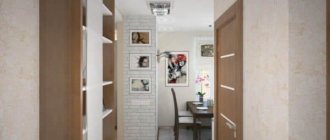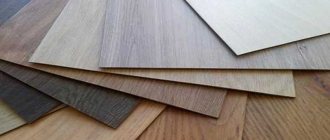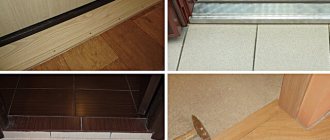How to make a technological joint between tiles and laminate
Curves at the point of contact of two floor coverings look beautiful in design projects and in photographs, but they are very difficult to make in real life.
In this lesson we will look at how to make a technologically advanced joint between tiles and laminate on straight and winding areas. Serpentine and complex transitions look beautiful only on projects and cause a lot of inconvenience
- In the hallway and kitchen - so as not to spoil the laminate from moisture and increase the wear resistance of the coating;
- For zoning a room;
- Under the doorway.
Quick navigation through the article
Floor covering requirements
Therefore, the following requirements are imposed on the coating and finishing:
- Maximum wear resistance;
- Moisture resistance;
- Low contamination threshold;
- Strength to mechanical stress;
- Practicality.
Also, you need to pay attention to the appearance and color. But this does not directly relate to the requirements, because all kinds of patterns and shades can be selected according to your tastes and preferences, there is no need to classify them and somehow combine them into something like a list.
You can argue for a long time which is better: tiles or laminate in the hallway. Or you can take and combine two types of flooring. Designers use this technique to visually delimit space without using costly methods.
What does the combination of two types of flooring give? Premises that are exposed to the greatest degree of pollution, such as the hall and kitchen, require different types of coating.
The entrance area of the hallway can be tiled, the rest of the floor - laminate. In this case, there is a visual distinction: dirty and clean.
The lobbies in apartments are often small; the use of different materials for flooring in combination gives the effect of visually increasing the space. The combined floor in the hallway made of tiles and laminate looks stylish.
The photo shows a combination of dark tiles and light laminate in the interior of the entrance area.
To combine laminate and tiles, you need to decide on the method of joining them. There are only three of them:
- Joint joint to joint, without the use of additional decoration elements;
- Docking with the help of moldings will effectively emphasize the contrast of the materials used;
- A cork expansion joint, which is laid at the border of tiles and laminate.
Each of these methods of combining two types of flooring has its pros and cons. For example, using molding in a hallway can allow dirt to accumulate underneath it.
In the hall it would be more appropriate to use the combination of materials using the end-to-end method. With proper delimitation and installation, the gap between the coatings will be no more than 1-2 mm.
READ MORE: How to lay laminate flooring on plywood
If you plan to lay laminate boards without gluing, then for a combined floor you can use a cork condenser, which will fix the laminate and prevent it from moving. It is important that the floor has a flat surface for this joining method!
Options for connection nodes
There are several ways to make a technological connection between laminate and tiles:
- Flexible PVC profile - suitable for any curved bends. Consists of a base and a decorative nozzle.
Flexible PVC profile Cezar
Flexible metal connecting profile
Standard aluminum sill
Door frame with threshold
According to the “Manual for the design of autonomous engineering systems of single-apartment and semi-detached residential buildings” (section Ventilation, paragraph 4.84), a gap of at least 2 cm must remain under the interior doors for air flow.
Solid wood profiles and thresholds
Transition profiles smooth out abrupt transitions between two coatings
Installation methods
Let's take a closer look at the installation features of each option.
Cutting tiles and laminate
When the seams between two materials are straight, there are no problems with their fitting, but it is difficult to trim the curved areas. To do this, you will need to make a template from available material (cardboard, polystyrene foam, etc.), using which to mark the future joint.
- A curved cut on laminate is made using a manual or electric jigsaw.
- The tiles can be cut to fit the curves of any shape using a grinder with a diamond tile disc, or manually with a jigsaw/hacksaw with a diamond string. You can also drill as many holes as possible along the cut line and break off the excess with wire cutters.
Installation of flexible PVC profile
Installation instructions for flexible PVC profile
- After laying the tiles and laminate, there should be a gap, the thickness of which will allow you to install the fastening profile and leave a temperature gap of 5 mm next to the laminate.
- Using a hammer drill, we drill holes for dowels in the expansion joint. If you have a heated floor running through the seam, then liquid nails can be used for installation, but it is better to exclude such cases at the design stage.
- We cut off the required length of the profile using a knife/hacksaw/jigsaw.
- We screw the fastening profile to the base with self-tapping screws.
- Before laying the decorative flexible profile, you need to soften it. To do this, place it in warm water (50-70 degrees) for 15-20 minutes.
- The decorative nozzle is inserted into the mounting profile and snaps into place.
Installation of flexible metal profile
- Before starting work, calculate the thickness of the tiles and laminate, taking into account the adhesive and backing - they must match.
- We manually give the required bend to the profile.
- Cut the required length using a grinder or a hacksaw.
- The profile has special claws for attaching it to the floor, so it is best to install it simultaneously with laying the tiles. The foot will be pressed against the tile with glue, and on the other side the backing and laminate will simply be inserted.
The profile is held in place by pressing with the tiles
Installation of aluminum threshold
A regular threshold with holes is installed as follows:
- Cut the threshold to the width of the doorway.
- Mark the drilling points at the joint.
- Drill holes, insert dowels and secure the threshold with self-tapping screws on top.
- To screw in self-tapping screws, use a screwdriver or screwdriver with minimal torque, otherwise the threshold will bend.
An important nuance: the measurement is taken taking into account the platband, and not just between the two extreme points of the box. Then the threshold is trimmed to fit the trim to avoid gaps.
If the threshold has hidden fastenings:
- The holes are marked on the base.
- A self-tapping screw with a dowel is inserted into the groove on the underside of the threshold.
- Holes are made in the floor.
- The threshold with the dowels on is inserted into the holes and hammered to the end. To avoid damaging it, strike it through a block pad.
Instructions for installing a threshold with hidden fastening at the junction of laminate and tiles
To remove the backlash, take a larger dowel and file the head
- Mark the outline of the sill on the flooring to ensure it is glued evenly in the center of the joint.
- Remove the protective film from the self-adhesive base and stick it on.
Hallway floor design
Using laminate for the entire surface of a corridor is not always a practical solution. Therefore, there are alternative options for combining laminate with other materials. Based on the functionality of this area, it is better to combine laminate with tiles.
The tiles can be laid where there is increased load. For example, near the front door. It is better to use porcelain stoneware or ceramic tiles in the hallway. When zoning the space, it is important to remember that the boundary between the laminate and tiles should be clearly defined. Therefore, it is not recommended to choose materials of the same shade.
Combination of laminate and tiles in the hallway.
Expert Yulia Kovtunova (Author, content manager) Work experience: 3 years, since 2020.
The hallway is somewhat limited in terms of combination, which is explained by the clear distribution of the degree of impact load on the floor covering. The patchwork technique is excluded: this way the space will be broken into parts, introducing a feeling of disorder into the corridor.
In order not to doubt how to lay it correctly (lengthwise or crosswise), it is worth taking into account the features of the hallway.
The design of combining textures depends on the skill of the master: if there is no experience, it is better to combine materials using clear straight lines. The installation can look like a tile or laminate backsplash, framed in contrast. If skill allows, the laying lines can be curved or turned, moving into another room or narrow corridor.
To understand what the combination of tiles and laminate is in the interior of a hallway, you can look at the zoning of experienced designers:
- The combination of solar tiles and brown laminate with a board texture, designed with a rounded line and complemented by a rug at the threshold in the same shade as the laminate, looks original;
- an interior in brown and beige tones will sparkle in a new way if you make a rug at the threshold from small soft beige tiles, decorated with floral patterns;
- You can accentuate the ethnic interior with the help of bright color contrasts: you can zone the space with a clear straight line, decorate the threshold with tiles with ornaments, combining them with a dark-colored laminate;
- if you don’t have experience, and the experiment just drags on, you can lay the tiles at the threshold like a ladder: this way it’s easier to do the work by combining two neutral shades using moldings or thresholds;
- the transition of materials can extend to other rooms: tile paths on a beige laminate background look original;
- The combined technique of smoothing out the interior decor is interesting: the contrast of white and beige finishes dilutes the dark spots of the room, making it softer through a curved line.
READ MORE: Do you need a backing for linoleum - what happens, do-it-yourself selection and installation
Any design project can be limited only by the imagination of the author. To create flooring in a residential area, you can use various combinations of tiles and laminate.
You can play with color contrast, differences in textures and joint relief. The floor in the hallway made of tiles and laminate in the photo is designed in the form of a wave.
To ensure that the color scheme of tiles and laminate does not conflict with each other, there are several simple selection rules.
Neutral colors usually go well together; the seam in such combinations is almost invisible. When purchasing materials, you need to combine them with each other to see the effect of the combination.
It is better to select contrasting combinations taking into account the design of the walls, but you need to remember that the design of the walls changes more often than the floor covering. Therefore, it is worth using classic contrast options that will suit any interior.
The tiles and laminate in the hallway in the photo visually divide the space into an entrance area and a relaxation area.
Since entrance areas most often do not have windows, it is better to choose light shades of laminate, which will make the interior of the hallway visually more spacious and brighter. The tiles in the entrance area may have a darker shade in order to hide marks from street shoes.
There are so many options for combining floor coverings that creating a unique floor design in an apartment or house is not difficult even for those new to renovation.
If choosing materials for flooring is difficult, you can always invite a professional designer who will create an interior design project for any part of the house, taking into account the customer’s wishes.
Laminate is an excellent option for a hallway because it has a long service life. Laminated imitation of natural wooden parquet has become popular for quite a long time. Thanks to its strength and beauty, laminated parquet gradually replaced not only expensive and capricious natural parquet, but also more functional tiles and linoleum from the first positions.
Among the variety of types of boards and their decor, choosing laminate for the kitchen and hallway is not so difficult. It is worth remembering that both of these rooms are places with high traffic, and in the kitchen there is also a special temperature regime: food is being prepared, the air is saturated with moisture and heated by electrical appliances and a gas stove. For such conditions, a laminate needs a special one, waterproof or at least moisture resistant.
All types of laminated boards are conventionally divided by manufacturers into classes. It is believed that laminate classes 21-23 are suitable for home use.
Reviews indicate that, in fact, such a board, which is not highly resistant to moisture, can and should be used in dry, impassable spaces - in the bedroom, children's room, on the balcony or loggia. If desired, class 23 laminate can be placed in the hallway if you live in a region where wet weather is rare and dirt and moisture are not brought in from the street.
In the kitchen it is recommended to lay laminate flooring of at least class 31
Commercial laminate 31-33 is considered suitable for walk-through spaces; it is more resistant to damage and water, that is, a waterproof model, ideal for the kitchen and hallway.
Water resistance or moisture resistance, what to choose:
- A waterproof laminate is one that is not only resistant to moisture, but also able to withstand a flood without the boards swelling or deforming;
- A moisture-resistant laminate will also not swell from spilled drops, but it will not hold a significant amount of spilled water.
A waterproof option is optimal for the kitchen, but it costs significantly more.
If a waterproof laminate is not available for a number of reasons, you can use the principle of combining materials: decorate the working part of the kitchen floor using ceramic tiles or porcelain stoneware, together with the laminate.
Different types of laminate and combining them with other materials make it possible to use such flooring not only in rooms, but also in the kitchen or hallway, where the risk of damaging the boards is quite high.
Laminated boards as a covering in the hallway have many supporters. However, the usual ceramic tiles, which are considered the most practical and functional, also have enough of them. What to give preference in this case?
If the hallway has a high traffic volume of people from the street, then it is better to give preference to tiles, and if it is small, laminate will also work well
Which floors are more convenient for the hallway:
- If we think not in a figurative direction, but in a practical one, then both coatings can be easily removed.
- Tiles are a harder and colder material; if there are small children in the house, it is better to give preference to laminate - it’s warmer to run on, and it won’t hurt as much to fall.
- If fragile decorative elements (vases, statues, floor mirrors) are installed in the hallway or corridor, tiles are also undesirable - the risk of breaking the decorations is quite high.
- But for a hallway where there is always dampness and a lot of dirt is dragged in from the street, tiles will be much more convenient than laminate - they are easier to wipe off and they are not afraid of water at all.
The choice of flooring for the hallway depends not only on your taste preferences, but also on the needs of the room. Choose laminate flooring for dry, spacious hallways, rooms where children will be present, or fragile interior decoration items will be installed. And in places with high traffic, in humid climates, it is worth using tiles. In any case, you can consider combining these materials if you want to use them at the same time.
In many ways, the result of installation depends on what tile is chosen when combining it with laminate. It happens:
- rectangular;
- square;
- hexagonal (honeycomb);
- curly.
If you use tiles in the form of squares and at the same time quite large in size on a small area, this will once again emphasize the cramped space. But rectangular tiles in a narrow corridor, laid crosswise in a striped manner, will make the room more spacious. The most installation options are in the spacious hallway, where you can lay out a real mosaic of multi-colored tiles, harmoniously combining them with laminate flooring.
Diagonal styling looks more original. Thanks to this, unevenness on the floor is perfectly hidden, and the corridor seems wider. However, in order to arrange the elements in this way, you need to have good skills in such work. And to achieve the result, it will take a lot of time, as well as material, since a large number of tiles will have to be divided into parts.
What is better to put in the hallway - tiles or laminate?
The apartment starts from the hallway. This room bears a large and varied load - water, street dust and dirt, slowly melting snow, dampness from drying shoes. All heavy and oversized cargo also ends up here first. What is better to put in the hallway - tiles or laminate so that the floor lasts a long time, resists deformation and abrasion and is beautiful? About this in our article.
Pros and cons of laminate
Laminate flooring is an innovative material that has experienced a boom in popularity over the last decade. Manufacturers are constantly working to improve the properties, correcting the shortcomings inherent in the products.
The main advantage of laminate is its low price, but high-quality samples that can withstand the load of the hallway well are expensive.
What else is good about laminate flooring?
- It is considered the warmest flooring option for an apartment after parquet. It can absorb shock loads due to a well-made screed and a high-quality substrate.
- Does not slip - almost all boards have a texture and roughness that imitates natural wood.
- A large number of colors, textures - panels do not always imitate wood, but can look like ceramic tiles, type-setting parquet, stone.
- Easy to install. Laying the substrate and panels and adjusting them to the geometry of the room is done quickly, without much dust or special skills.
Carpet in the interior: a dust collector or a practical solution?
Carpet invites you to walk barefoot, warms the interior visually and literally, absorbs noise well, and makes any room more comfortable. But for some it evokes associations with the floor in the office. And some even classify such a coating as a dust collector. Let's talk about the pros and cons of carpet in the interior.
There are also serious disadvantages that are relevant specifically when installing in a hallway:
- if water gets into the joints or under the baseboard, the boards may swell and never return to their previous state - the coating will have to be changed;
- due to static electricity, it can attract dust and dirt from shoes, fleecy woolen clothes, coats, etc.;
- a large or medium-sized dog may begin to leave scratches with its claws over time;
- heavy shoes and thin heels contribute to abrasion more than slippers in other rooms.
These disadvantages are typical for inexpensive coatings, so we recommend installing a commercial waterproof laminate of 32–33 classes. It withstands the loads inherent in the corridor much better.
Tile in the hallway
Tile as a facing material can be used in the hallway for finishing walls, floors, and ceilings. However, decorating the ceiling is rare, since it visually fragments the surface.
For floor
Ceramic floor tiles are used mainly because of their characteristics. The hallway is subject to increased loads. Dust, dirt, and household waste constantly fall on the surface. You need to select a tile according to the following parameters:
Corridor in “stone”
- Wear resistance. The floor in the corridor receives the most damage; you need to choose tiles of strength class 3-4.
- Water resistance – there is no constant dampness in the room. However, the surface often comes into contact with water and dirt. The tiles should not be made of porous materials. The percentage of water absorption should not exceed 5% - class II-A.
- Increased resistance to chemicals. Depending on the region, dust and dirt may contain a significant number of chemicals. The tiles must be resistant to detergents. Goods of class A and B are suitable.
- Smoothness. Exposure to moisture significantly increases the risk of injury. Products made of porcelain stoneware, glaze, clinker are slippery. Terracotta and clinker with natural roughness and anti-slip stripes are suitable.
- The design is matched to the color of the hall. However, from a practical point of view it is also necessary to evaluate products. On a light, monotonous surface, dirt is more noticeable than on a dark one. It is advisable to use tiles with ornaments and several chaotic colors.
For walls
Wall tiles are usually marked with a handprint. The requirements for strength and security are below:
- Water resistance is not important. Even class III tiles will hold up well.
- A high level of wear resistance is not required.
- Low resistance to active chemicals is acceptable.
Room zoning
Advantages and disadvantages of tiles
Tile is a much more expensive type of finishing. It can be made of different materials - ceramics, porcelain stoneware or PVC with various additives that increase strength. Moreover, the latter is easy to install, does not require special construction skills and can be replaced individually, without destroying the surrounding coating.
The advantages include:
- resistance to water, dirt, ease of cleaning;
- resistance to external damage – especially porcelain stoneware;
- Stylish appearance - tiles can also imitate parquet boards; you can choose from a large assortment of models for any room design.
Imitation of natural materials in tiles
Today in interior stores you can find a large number of tiles imitating natural materials. In this article we will talk about how to choose the right styling, what you should pay attention to, and what interior styles this finishing option will fit into.
The main disadvantages of tiles are the high cost and complexity of installation. Given the non-standard dimensions of most rooms, you may need a tile cutter, which will make installation quite dusty. Also, tiles tend to be quite cold, so walking on them barefoot can be unpleasant (unless you use an underfloor heating system).
These disadvantages are irrelevant when using PVC tiles: they are lightweight, easy to install, however, like other coatings, they require high-quality surface leveling.
Advantages and disadvantages of the material
Porcelain stoneware, like any other material, has both advantages and disadvantages.
Obvious benefits include:
- High strength and durability (there are practically no cracks or chips);
Among the disadvantages are:
- Difficult to install;
Some shortcomings can be avoided if you choose tiles with a matte or textured surface and insulate the floor.
How to make the transition from tile to laminate flooring with your own hands
Many builders and interior designers have recently been inclined to choose a combined floor covering, using several facing materials within the same room. The article will discuss how to make the transition from tiles to laminate, decorating it with your own hands so that the seam between the materials does not create visual and operational discomfort.
Combination of tiles and laminate flooring: design ideas for the hallway and kitchen
A few smart recommendations:
- When combining, it is better if the two coatings differ in the same direction of laying, thus, it is possible to achieve a smooth flow of one material into another and create a more complete composition.
- Zigzag and uneven joints are much easier to install with staggered tiles.
- To make the connection between the coatings look less noticeable, it is possible to use a podium. For example, in the kitchen space you can create a difference in the floor between the working and dining areas.
- If single-level masonry is used, it is important to choose the correct shape of the joint; a connection in the shape of a semicircle looks especially harmonious and beautiful.
- In terms of color, it is advisable to use a combination of warm shades with warm and cold ones, also only with similar tones.
- For small rooms, it is better to choose cladding in light colors, and use dark coverings in more spacious rooms with high ceilings.
Combinations of shape and texture
Such combinations allow you to give the coating a brighter and more interesting look. When using this design, it is desirable that only one part of the decoration be expressive, and the other act as a background. For example, you can combine matte and glossy tiles, models of different sizes or products with a pattern, but the laminate should have a very simple design.
Depending on the shape, tile products may also differ in transverse, longitudinal, diagonal, herringbone or checkerboard layout.
The photo shows a multi-colored honeycomb tile finish in combination with a laminate board in the interior of a modern kitchen.
In the case of tiled cladding with an imitation of the texture of marble stone, textiles or leather, it is better to use a laminate board of a darker shade, this will further emphasize the noble appearance of the designed surface and endow the space with real luxury and sophistication.
The photo shows black hexagonal tiles combined with laminate in the kitchen interior.
Hexagonal tiles, which are distinguished by a wide variety of shades and structures, will look especially stylish and unusual. Using products in the form of honeycombs or diamonds, you can achieve quite original and non-standard compositions, unusual effects and an almost seamless surface. In addition, such finishing provides interesting zoning of the room and creates a unique broken transition with laminate.
Color combinations
When choosing a color combination, it is important to consider what kind of atmosphere is intended to be created in the room. For example, for a laconic interior, they often prefer tiles and laminate boards, which have the same tone in warm or cold tones.
The photo shows a kitchen combined with a living room with a tiled floor combined with laminate of the same color.
A gray laminate will perfectly complement the bright tile finish, which against the background of this monochrome shade looks more subdued and at the same time expressive. For gray floor tiles, they prefer laminate boards in dark colors or with a pattern that contains gray inclusions.
For an unusual and memorable design, contrasting shade combinations of two colors are selected, not only for the flooring, but even for the baseboards. A very interesting design technique to smooth out the interior is to combine white and beige finishes, which somewhat lightens the dark areas of the room, and in the case of a curved joint, gives it a special softness.
The photo shows a contrasting combination of tile cladding with laminate in the interior of the kitchen-living room.
Combined tile and laminate floors in the hallway
For the hallway, a similar finishing option is often used. Basically, using tiles, they lay out the floor near the front door, and the remaining half of the space is lined with laminate, thereby zoning the room. In this combination, it is especially important that the tile material for the area near the door is particularly durable and resistant to moisture.
The combination of two floor coverings can have a joining of various straight, curved or rounded shapes. The connection can be without a threshold or with a border, which is relevant when the materials are located at different heights or are joined differently.
The photo shows the interior of the hallway with a combination of black square tiles and brown laminate.
In the corridor, the tiled cladding should preferably be matte, since the presence of scratches and abrasions is less noticeable on it. For a small hallway, it is better to use not too large modules with a minimum number of ornaments so that the covering does not create a feeling of bulkiness.
The photo shows a white hexagonal tile finish, turning into laminate in the interior of the corridor.
Kitchen floor design made of tiles and laminate
This combination of facing materials is a very successful and practical solution, thanks to which it is possible to achieve visual zoning of space. In this case, tiled finishing is used in the work area near the kitchen unit, and laminate is used in the dining room. Tile with a glossy surface, in combination with a cozy wooden covering, will give the environment a special atmosphere and create a balanced design.
The photo shows a kitchen-living room with zoning made by combining light tiles with dark laminate boards.
An equally interesting visual division of the room can be achieved in a more spacious studio or in a small kitchen combined with a living room, in which, using an interesting combination of materials, you can create several visual zones at once.
The joining of two flooring materials in the kitchen can be done either in a straight line or in the form of a wave, curved or broken line. For example, for a kitchen interior with a predominance of strict geometric shapes, it is better if the seam is straight, but if the design has wavy transitions or furniture with smoothed corners, a curved connection would be appropriate.
Modern flooring
Today, in many rooms, floors are covered with a material based on the characteristics of the coating used. Differences in characteristics led to the invention of zoning technology for the entire house or individual rooms.
The following materials are suitable for installation in specific rooms:
- parquet flooring and natural stone coverings are most often used in living rooms and offices;
- tiles, due to their resistance to wear, moisture, chemicals and other types of aggressive effects on the coating, are used in kitchen units, sanitary facilities, and sometimes in hallways. If in a ceramic-lined room it is necessary to lay an area with more comfortable performance characteristics, it is recommended to study the instructions on how to make the transition from tiles to laminate with your own hands;
- special attention is paid to bedrooms and children's rooms, which are an “intimate” part of the house, where residents should feel cozy and comfortable. It is recommended to use carpet as a floor covering in these rooms.
Disadvantages of porcelain stoneware
Despite the strength, durability and presentable appearance, this finishing material also has many significant disadvantages, such as:
- high price;
- shade mismatch;
- high probability of counterfeit;
- surface too slippery and cold;
First of all, it should be mentioned that it is unpleasant to walk on this type of coating, as the floor turns out to be cold. Unfortunately, it is impossible to insulate it using thermal insulation materials. The hallway is a passage room, and the comfort factor is of particular importance. The problem can be solved by installing an electrical “warm floor” system, but this significantly complicates and increases the cost of finishing.
Attention! Porcelain tiles have a slippery surface, which means there is a high risk of an accidental fall. Since the floor in the hallway may be wet in winter and autumn, using porcelain stoneware as a floor covering becomes even more unsafe.
You can also decorate the hallway using other, equally high-quality materials that will be just as wear-resistant. Porcelain tiles have a high cost. It will fit perfectly into the interior of a spacious hall in a rich mansion, but for an ordinary hallway it is better to choose a budget option, for example, parquet with a high wear resistance class.
Another disadvantage of porcelain stoneware is the difficulty in choosing a quality material. It is believed that the highest quality coating is produced in Italy, however, you can find good products from Belarus, Turkey, Russia and Greece.
True, even Italian coatings are not always of good quality, because in Italy there are more than 300 companies producing tiles, and not all of them focus on durability and durability.
Important! The whole difficulty lies in the fact that there are a huge number of fakes on the construction market that are almost impossible to distinguish from the original. For an artificially high price, you can get low-quality and short-lived material.
To choose the right tile, you need to learn how to choose this material yourself. It is almost impossible to determine the quality of a tile by appearance, because its characteristics depend on the temperature at which it was processed, what mixtures were used, what pressing technology was used.
However, there are some points that are worth paying attention to. If the material is light in weight, it is better to refrain from purchasing it. Tiles with a thickness of 9 mm must weigh at least 19 kg per package. In addition, you need to carefully examine the back side of the tile; there should be small depressions on it, no more than 2 cm in diameter; the larger they are, the worse the quality of the product.
Porcelain tiles are not the most suitable finishing material for a small hallway in an apartment. This type of coating is slippery and cold, expensive, and heavy, which significantly complicates installation. It is better to choose high-quality parquet or laminate for finishing.
Tile and laminate next door
Today, it is not uncommon to find a combination of tiles and laminate in the same room or adjacent rooms. This association did not arise by chance, because coatings have individual advantages.
This allows them to be used for radically different purposes:
- tiles are resistant to mechanical stress, as well as moisture and chemicals, it is easier to clean it from dirt, but despite its strength, it has a solid structure that creates discomfort when walking;
- laminate is cheaper and more varied in terms of surface color and applied texture options.
In this regard, the connection of laminate with tiles is the basis for obtaining high-quality, durable and reliable flooring that will last for many years. All that remains is to figure out how to install such materials next to each other.
Advice from professionals
The combination of tiles and laminate in the hallway has its advantages.
- Increases the practicality and service life of the floor, both in terms of resistance to mechanical stress and in terms of maintenance of the coating. The tiles are placed in places where the load on the floor is especially high, and the laminate serves as a kind of transition from the threshold to the rest of the hallway.
- Due to the division into 2 sections, decorated with different materials, the space in front of the entrance becomes visually larger.
- The combined floor looks original. Moreover, it is possible to decorate it in any style.
- The use of laminate and tiles, on the one hand, makes it possible to lay expensive materials, and on the other hand, the costs for them are not so high, given that only a small amount is needed. Sometimes it is enough to use something that was not useful during repairs at another facility, or to use the remnants of an unsold batch of material in a store. The price of such products is often reduced.
- Both laminate and tiles are environmentally friendly. Therefore, you don’t have to worry about the well-being and health of your household.
There are also disadvantages to combining.
- You need a reliable base for the tiles. If you lay it in the hallway of a house with wooden floors, you will first need to make a screed with reinforcing mesh. This will cause the floor level to rise. This, in turn, will make it difficult to open doors or join the tiles to other areas of the flooring.
- The joints themselves are the least reliable place on the floor where laminate and tile are combined. As cleaning proceeds, the grout is washed away and the joining materials are broken. To prevent this place from becoming “sick” for as long as possible, you will have to take care of purchasing the highest quality materials and ensure that specialists pay special attention to the accuracy of connecting the two areas.
- There are much fewer color options for laminate than for tiles. In addition, you need to take into account the texture and thickness of the tile covering when selecting it for combination with laminate. If you are guided only by how both materials look from the outside, during the repair you may find unpleasant surprises that will negatively affect the result.
- Drawing up a drawing that includes all the nuances of the arrangement of pattern elements and their adjustment taking into account the joint takes time. In certain situations this is also a disadvantage. And if you decorate “by eye”, you can get the opposite effect than intended.
The colors of the tiles and laminate themselves create a certain visual effect. If you choose white tiles, it will be combined with other finishing materials of any shade. Another question is that this choice is not very practical, since on a rough tiled surface, which is exactly what it should be at the threshold, dirt is especially visible.
For example, gray tiles are popular when decorating a corridor because they do not clash with any wall color. You can choose “stone” shades of gray and combine them safely with laminate flooring of almost any shade.
If you want to play with contrasts, it is better to take into account the design of vertical surfaces in the hallway, not forgetting that the installation of the floor will take a long time, but the design of the walls is changed much more often. Therefore, when selecting contrasting colors, it is advisable to use traditional techniques, which will later “fit” the old floor into the updated interior.
The selection of tiles “for laminate” greatly simplifies the matter. This one is on sale. Externally, it is almost impossible to distinguish it from laminate with its traditional wood patterns, so there will be no problems when combining it.
It makes no sense to precisely select the shades and textures of tiles and laminate. Still, differences in tone cannot be avoided. In addition, the complete absence of difference will make the color scheme boring, and the difference in textures will not help. With a slight discrepancy in color, it will become almost invisible.
Today, the approach to floor design is more demanding than before. The floor covering should be attractive, reliable, easy to maintain and perfectly preserve the beauty of its appearance. Tiles and laminate look good together, and it is difficult to choose the best type of material for the hallway: this room of the house requires especially durable floor coverings.
The combination of tiles and laminate can be called the golden mean in floor design.
This cladding performs several functions:
- it allows you to zone the hallway space, facilitating the organization of each section;
- through it you can beat the lack of usable space, visually increasing the space;
- The cladding method allows for areas with greater traffic to choose a more durable material that is resistant to abrasion and weight load;
- she can make the flooring fashionable, pleasant and homely, imitating different types of surfaces (including creating the appearance of carpets that make the atmosphere of the room cozy);
- add your own flavor to the interior by bringing together disparate items of existing furnishings.
At first glance, it seems that the two materials are quite different and have noticeably different performance characteristics.
Both materials used are quality floor finishes. Combining them is a bold and fashionable design technique.
This cladding has a lot of advantages, since it:
- appropriate in premises of various types (residential apartments, country houses, cottages, offices, studios, industrial premises);
- fits harmoniously into different interior styles, regardless of direction, be it classic, modern or ethnic;
- can tie together different types of finishing of all rooms of the home (for example, when floor tiles are used in the kitchen, and laminate is used in the bedroom);
- often allows you to save the family budget: if the hallway area is small, you can use leftover material for work after tiling other rooms;
- is an excellent solution for the design of flooring in any interior, allowing you to extend the life of the floor and simplify its repair, if the case requires it;
- allows you to correctly calculate the level of load on the floor surface, using material that is resistant to moisture, water and abrasive substances in places of greatest load;
- brings style to boring interiors made in a single color scheme, drawing attention to the sophistication of the design solution;
- is a hygienic cladding, harmless to users;
- allows you to purchase the correct quantity without overspending and adding material for waste, allowing, if necessary, a change in the design of the floor covering.
READ MORE: Porcelain tiles on the floor: do-it-yourself installation technology
Both materials are convenient in that they make it possible to cladding the structural features of the room (protrusions) without any problems. If you wish, you can always buy raw materials taking into account your existing budget and your own preferences, because often you don’t need a lot of material. By the way, this factor makes transportation easier.
The choice of materials must be considered. Not every mix is worthy of attention and admiration. Sometimes the problem lies in the selection of raw materials itself. For example, laminate is more limited in color range; tiles for it are selected taking into account texture and the correct thickness. If you approach the choice based on external characteristics, the floor covering may differ in level of location, which can deprive it of its attractiveness.
If you make a design “at random,” the room runs the risk of becoming not just asymmetrical: it can “move” to the side, having a skew. Lengthy preparation is, although small, a disadvantage. Not everyone will like the execution of a drawing with the application of each fragment of the pattern, its adjustment taking into account the seams.
Joints are a sore subject in repairs. They are the weak point of the flooring. In addition to gluing the basic materials and preliminary surface preparation, you will have to take care of high-quality raw materials for joining. Frequent cleaning can gradually wash out the grout, and connecting structures often break off under constant mechanical stress.
It is worth keeping in mind that not every type of material is suitable for the job. This is especially true for laminate flooring, which is classified according to the degree of appropriateness in a specific type of room. For example, for residential rooms, manufacturers offer 21, 22, 23 classes of material, for commercial premises there are 31, 32, 33 classes.
This material can be used in rooms with high humidity. It is important that its class is at least 31: this way it will correspond to the strength level of the tile and will not wear off before it.
The choice of tile is no less important. It should be floor-mounted: this material is much stronger than tiles, and the manufacturing technology for the ceramic version differs from the usual kitchen counterpart. Porcelain tiles are created by molding and pressing under high pressure. You can choose both types: they are hygienic, wear-resistant, strong and durable. Masters believe that porcelain stoneware is even better than tiles.
Since laminate tends to swell when the back side is in contact with water for a long time, it is important to provide protection against moisture getting into the installation seams. To protect the designer coating from water, you need to treat the seams with a layer of mastic with protective wax.
In addition, it is worth taking note of a few recommendations:
- when buying a laminate, choose a material with locks: it is more practical than the option with glue, and if necessary, it is easy to disassemble and remake;
- pay attention to the thickness of the laminate: 12 mm is preferable (it is more expensive, but the locking system will be more reliable);
- do not take smooth glossy material: it is slippery, easily soiled and shows any dirt (matte surfaces are more practical);
- to combine two materials without a difference in floor level, you can use special thresholds made of metal, plastic or cork;
- bending contrasts is appropriate if similar lines are present in the design of the walls or ceiling.
Features of joining tiles with laminate
First of all, the joint must fit harmoniously into the environment so as not to stand out visually and geometrically in the general plan of the floor covering. Thresholds are usually used to improve adhesion and decorate the joint seam.
It is important to understand how to connect laminate and tiles on the floor in such a way as to achieve an ideal, even coating with a long service life.
Places for using combination styling:
- In kitchen blocks, natural joining of materials is most often used. It is popular to create podiums - special elevations that, in addition to their decorative function, absorb height differences between adjacent materials. Single-level coatings fit together much worse, since it is more difficult to lay materials at the same height and you will have to try hard to connect them with a decorative profile;
- Also, the combination of laminate and tiles in the hallway justifies its creation. Naturally, it would be safer to use tiles near the door itself, since such a coating is not afraid of the mechanical impact of shoes, falling of various objects, etc. And it’s much easier to clean up after everyone entering the house if such a covering is installed;
- in the living room it is recommended to return to laminate again, since its use is more comfortable, but you cannot completely abandon tiles and with its help you can effectively decorate areas near the fireplace, under windows and in doorways.
introduction:
The floor in the hallway is daily exposed to dirt, moisture, sand brought from the street, and sharp heels. To ensure that the coating retains a neat appearance for a long time and is not afraid of moisture, mechanical influences and detergents, its choice is taken very carefully.
Despite the abundance of options, the most popular is tile, which, due to its combination of properties, is an ideal covering for a hallway, but not every tile will fit well. Let's study the question up and down and determine which tile to choose for finishing the floor in the hallway, what operational and decorative qualities it should have.
About the pros and cons:
The basic properties of tiles are familiar to many of us due to their widespread use. This is an ideal material for a hallway, as it has the following advantages:
- durability. It’s worth spending once on the purchase and installation of a coating, and it will serve you for decades, subject to normal care;
- ease of care. Keeping the tiles clean is not difficult, you can use a lot of detergents, and dirt can even be scrubbed off with brushes;
- moisture resistance;
- wear resistance. Tiles don’t care about heels, sand, or abrasive cleaners;
- hygiene;
- a wide selection of colors, patterns, formats, so there will be no difficulties in decorating the hallway in a certain color or style.
It is also better to know about the disadvantages in advance.
Firstly, this is a cold material, so you won’t be able to walk barefoot in winter, but with the help of ordinary slippers this problem can be solved.
Secondly, tiles are characterized by fragility: if you drop something heavy, there is a high probability that the material will be damaged.
If the hallway is of impressive size, then a tiled floor can add excessive severity and resemble the lobby of a government institution. There are several ways out of the situation: use a combination of tiles with other finishing materials or turn to warm, cozy colors.
Docking threshold
The threshold is a regular strip that is applied to the joint between adjacent materials (for more details: “How to properly make a joint between tiles and laminate - methods”). If the question arises about how to connect laminate and ceramic tiles, then it is best to resort to using plastic thresholds.
The advantage of plastic is that it has high elasticity and a wide range of colors. It makes the transition from ceramic tiles to laminate flooring very easy. As for installation, it is very simple and easy to do with your own hands.
By design, there are two main types of decorative thresholds:
- collapsible - most often consist of a substrate and a threshold inserted into it;
- solid - a single structure that can be mounted by screwing in ordinary self-tapping screws or gluing to joining materials.
In this regard, fastening is of two main types:
- hidden - when all the materials used are covered with a plank;
- open - the fasteners do not protrude over the threshold, but are visually distinguishable and noticeable in published photos, which makes the coating not of the highest quality. Typically, dowels or screws are used as fastenings.
Porcelain tiles in construction and repair
About creating porcelain tiles
The material was created in the 20th century. It contains slip - a homogeneous mixture of clay and kaolin, quartz sand, feldspars and pegmatites, and water. Press powder is made from these components. It is pressed with a pressure of 400 to 500 kg/cm2. Then it is fired at 12,000 C. Initially, tiles were produced from it that could withstand very heavy loads. Now new colored types of porcelain tiles have appeared. The color appears due to the introduction of various oxides. They disperse during firing and color the semi-molten mixture. It is due to this that the color of different batches may differ slightly. For example, zirconium salts are added to give a bright green color. If you want to get a blue tint, then cobalt compounds are added to the mixture. At the same time, colored porcelain tiles are more expensive than usual. This is explained by the high cost of coloring pigments. Cost reduction can be achieved through partial coloring of the top layer. At the same time, it is impossible to determine by eye whether a completely painted porcelain tile is used or only on top.
Despite the constant improvement of production, porcelain stoneware is only a skillful imitation of natural stone. Whether this is an advantage or a disadvantage - everyone decides for themselves. Unlike natural rocks, the finish does not have any radiation background, and natural stone, at least a little, is phonic. There are designer finishing options interspersed with pebbles and shells. It looks quite attractive.
Features of finishing material
Many people confuse porcelain tiles and ceramic tiles. The technological principle and composition for production are the same, the only difference is that in the production of ceramic tiles a more gentle temperature regime and “lighter” (at lower pressure) pressing are used. However, everything listed below is fully suitable for both porcelain stoneware and ceramic tiles. Distinctive features of these finishing materials are:
- Requires minimal maintenance, just remove dust.
- Wear resistance, best performance. The quality is maintained for many years with regular use.
- Not subject to cracking and chipping.
- Not susceptible to pigmentation from chemical compounds. Even the solvent is not scary for him.
- Convenient for use in industrial premises.
- Strength. When properly installed, it can withstand up to several hundred kilograms per square centimeter.
Processing a joint using a threshold
The role of thresholds is very important in the process of making the transition from tiles to laminate with your own hands. A properly installed threshold between the tiles and the laminate will protect the edges of both covered floorings from destruction.
Installation is carried out as follows:
- it is important that the floorings on both sides of the joint are located at the same level;
- Before connecting the laminate to the tiles using a threshold, it is recommended to make a uniform seam between the two floorings;
- then the purchased strip is mounted using the chosen method.
Combined flooring - a bold solution to modern design (100 photos)
Due to small-sized apartments, studio apartments are increasingly being created. With an open plan, the living area is combined with a kitchen or a recreation area (living room). How to divide zones?
They use bar counters, different lighting, screens, etc. But the most effective method will be a combined floor.
Application
It is better to combine completely different finishing materials on large areas, they reduce the volume. Combined floors in the interior are often used in the hallway-living room or kitchen-living room, where zoning is necessary.
When decorating a kitchen, it is better to lay the floor with ceramic tiles in the area where food is prepared. Separate the dining area with laminate flooring. The tiles should be 1 meter or more in front of the refrigerator, sink and stove to protect the laminate from water and oil splashes.
Combined floors are practical and durable. They will divide the hallway (corridor) or kitchen into zones using one color.
Designers often offer this approach to dividing space to emphasize the individuality, volume and beauty of the premises. This zoning method can be used in the living room, bedroom or veranda.
Choosing a hallway cover
The corridor is always subject to damage and frequent washing. Dirt from shoes and heels also constantly test the flooring material, so there are many requirements for it:
- Resistant to heavy loads, aggressive detergents and humidity.
- Wear resistance and long service life.
- Anti-slip qualities.
- An organic combination with the overall design concept.
- Easy care of the coating.
Therefore, in hallways (corridors), tiles are often chosen for the floor at the entrance, and the rest of the area is covered with laminate. This is the most practical and multifunctional.
Wooden and parquet boards are less commonly used for combining. Despite the strength and beauty of the wood, it is better not to use them due to difficulties in cleaning, as well as the instability of the wood to dirt and high moisture.
You can replace laminate or tile with linoleum (commercial or semi-commercial). It is not afraid of moisture and dirt, but will gradually lose its appearance due to increased humidity.
Kitchen floors
The design of a combined floor is used for zoning combined rooms. An excellent option for a work area would be laminate tiles, but for a hall or living room it is better to choose a material with increased strength. Both materials should be in harmony both in color and texture.
With any choice of materials for the floor, their thickness will be different. For example, laminate flooring with tiles is difficult to connect. That’s why sometimes the work area is raised a little, and the dining room is made a level lower.
The combined floor should be selected carefully for the kitchen; here the humidity and temperature are higher than in other rooms. Sharp or heavy household objects may sometimes fall.
Methods for joining floor materials
The main thing in flooring is the joining of different materials so that there are no obstacles when walking and the aesthetic appearance is preserved. But how to design a combined floor?
If the joints are at the same level, then thresholds made of wood, plastic or aluminum are often used. They will help hide roughness and create a beautiful transition from one coating to another. This is the easiest design method that you can do yourself. The thresholds will protect the edges of the flooring materials well so that dirt cannot penetrate into the cracks.
Butt fastenings are also common, but this method requires a lot of experience and accuracy. It is used for wavy smooth transition lines. This is the most effective combination of two floor coverings.
Sometimes silicone sealant is used; mastic or foam (construction) is suitable for joining floor materials. This method will hide gaps of any shape between the tiles and the laminate.
If you do not have sufficient experience in finishing work, contact professionals. Consultants will help you choose the right finishing material based on texture and color scheme. You can view the finished works in the photo album.
Photos of combined floors
Help the project, share with friends











